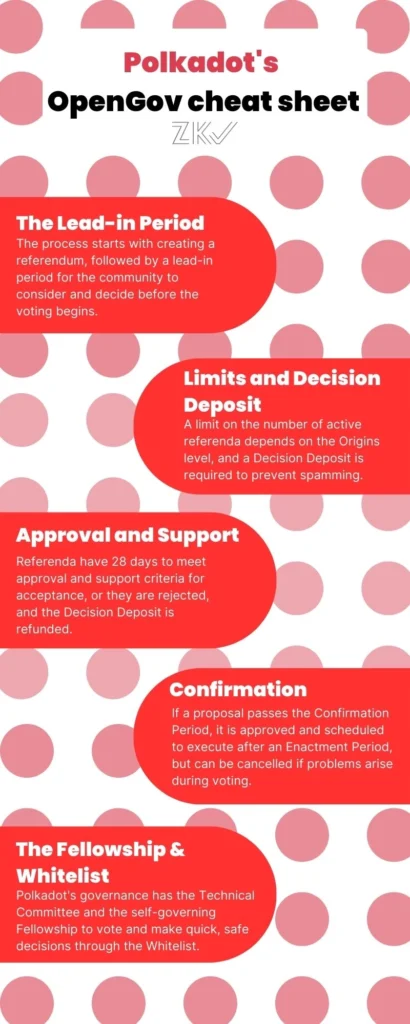The New Polkadot Governance Process Explained
A summary of the most important aspects of Polkadot’s OpenGov.
Polkadot is about to go through a change in the approach of governance once it enacts the OpenGov model. In this system, community members propose changes to the network, known as referenda, and the community then votes on these proposals to decide whether they should be implemented.
But, how exactly does this process work? Let’s take a closer look.
Read what you need
The Lead-In Period
The first step in the process is the creation of a referendum. After the proposal is created, there is a set amount of time that must pass, known as the lead-in period, before voting can begin. This lead-in period is important because it gives everyone in the community sufficient time to consider the proposal and decide whether they want to vote for or against it.
Limits and Decision Deposit
There is also a limit on the number of referenda that can be in the “deciding” state at any one time, and this limit depends on the level of Origins allowed on the track. Additionally, to prevent spamming or bloating the system, there is a requirement to pay a Decision Deposit.
Approval and Support
Once a referendum enters the “deciding” state, it is eligible to be approved for a limited time of 28 days. To be approved, the proposal must pass two criteria: approval (the share of approval vote-weight against the total number of vote-weight) and support (the total number of votes in approval compared to the total possible amount of votes). The approval and support requirements may vary for different classes of referenda and can reduce over time. If the proposal is not approved after 28 days, it is considered rejected and the Decision Deposit can be refunded.
Confirmation and Enactment Periods
If the proposal becomes passing for the Confirmation Period, which is specified by the track, it is considered approved and scheduled to execute after some Enactment Period. The Enactment Period is also specified when the referendum is proposed and is subject to a minimum value based on the track. If a proposal that is already being voted on is found to contain a problem, it can be cancelled through a special operation called “Cancelation.”
The Fellowship and Whitelist
In Polkadot’s governance system, the role of well-informed expert opinion is crucial. However, it is also important to ensure that these experts do not have too much power and authority. This is why the original Technical Committee was designed to have limited power.
To help facilitate the process of quick decisions, such as upgrades, fixes, and rescues, Polkadot introduced a new governance body called the Fellowship. The Fellowship is a self-governing group of experts who represent the technical knowledge base of the network. Members can become candidates by placing a deposit and are associated with a rank to indicate their level of expertise and the weight of their opinion in Fellowship decisions.
The Fellowship votes on proposals using the same code as the Polkadot stakeholders and has the ability to reduce the voting period of a referendum. However, it does not have any hard power over the network, such as the ability to change parameters or conduct rescues. The rank system and weights are designed to prevent small groups of individuals from capturing and controlling the network.
Another important aspect of Polkadot’s governance system is the Whitelist. This is a list of approved proposals that have been deemed safe and time-critical by the Fellowship. The Whitelist streamlines the decision-making process by eliminating the need for a full referendum when quick action is needed. This allows the network to make decisions in a timely manner while still ensuring the safety of the network and its users.
Conclusion
In conclusion, the Polkadot Governance Process is a system that allows the community to make decisions about the future of the network through a series of steps and checks. The Lead-In Period provides sufficient time for community members to consider proposals before voting begins. There are limits on the number of referenda and a requirement to pay a Decision Deposit to prevent spamming. To be approved, the proposal must pass approval and support criteria. If it does, it is scheduled for execution after a specified Confirmation and Enactment Periods. The Fellowship and Whitelist play important roles in the governance process by providing well-informed expert opinions and streamlining the decision-making process. This system is designed to ensure that decisions are made efficiently and effectively while still maintaining the safety of the network and its users.
Cheatsheet

